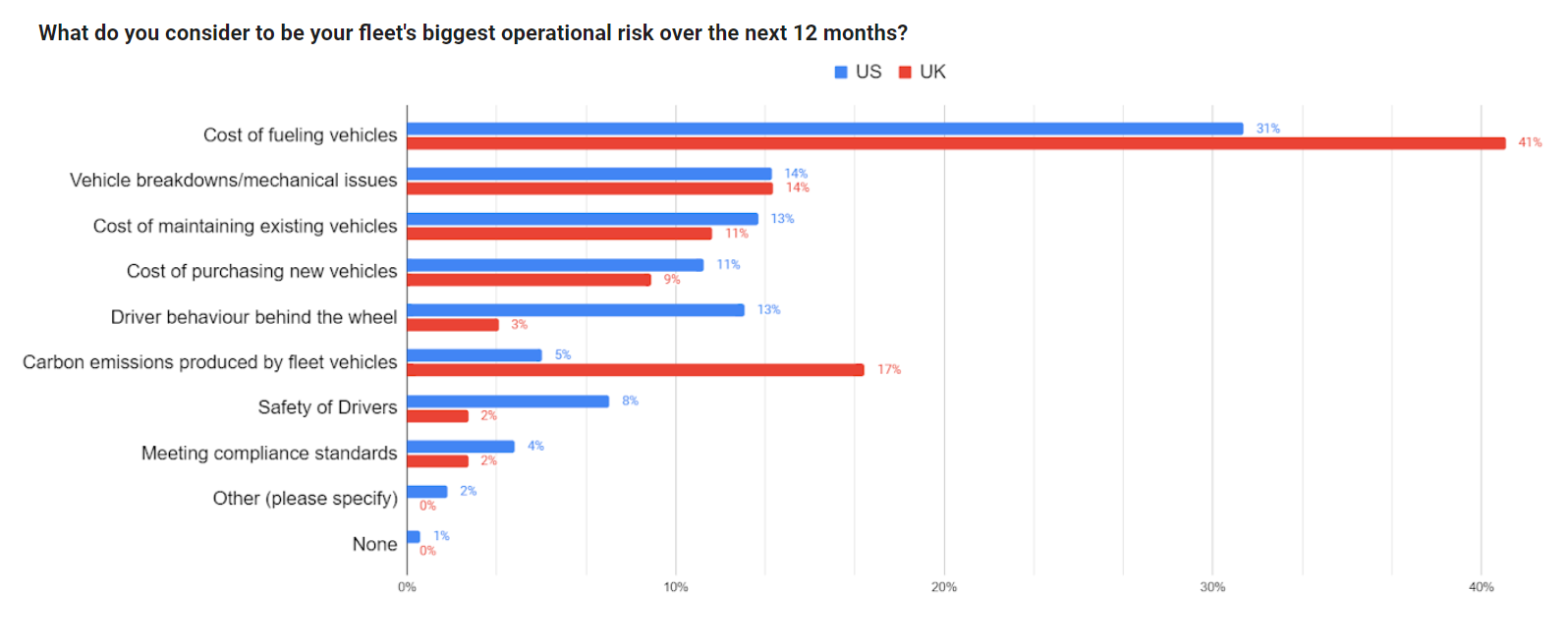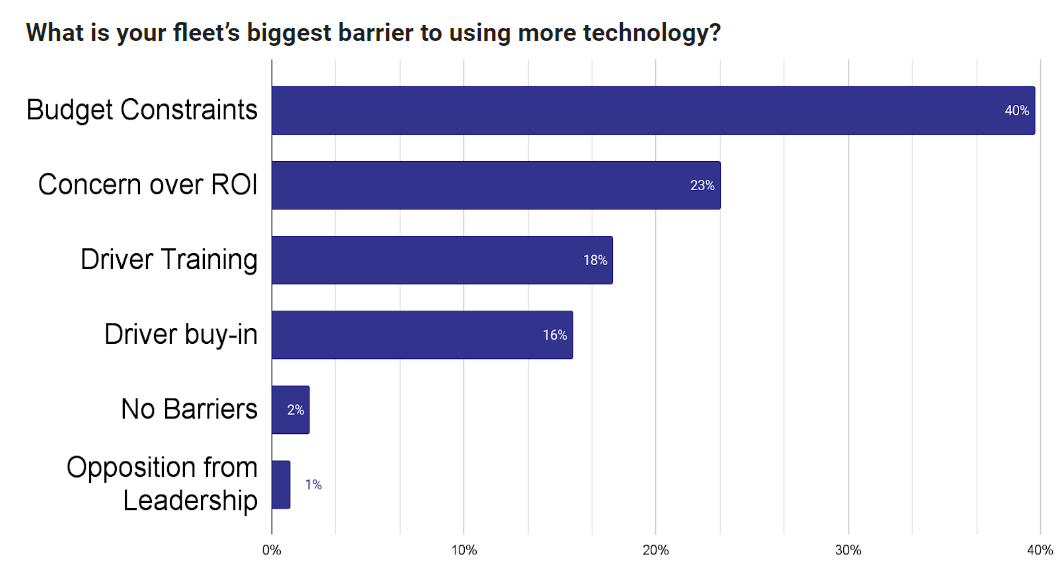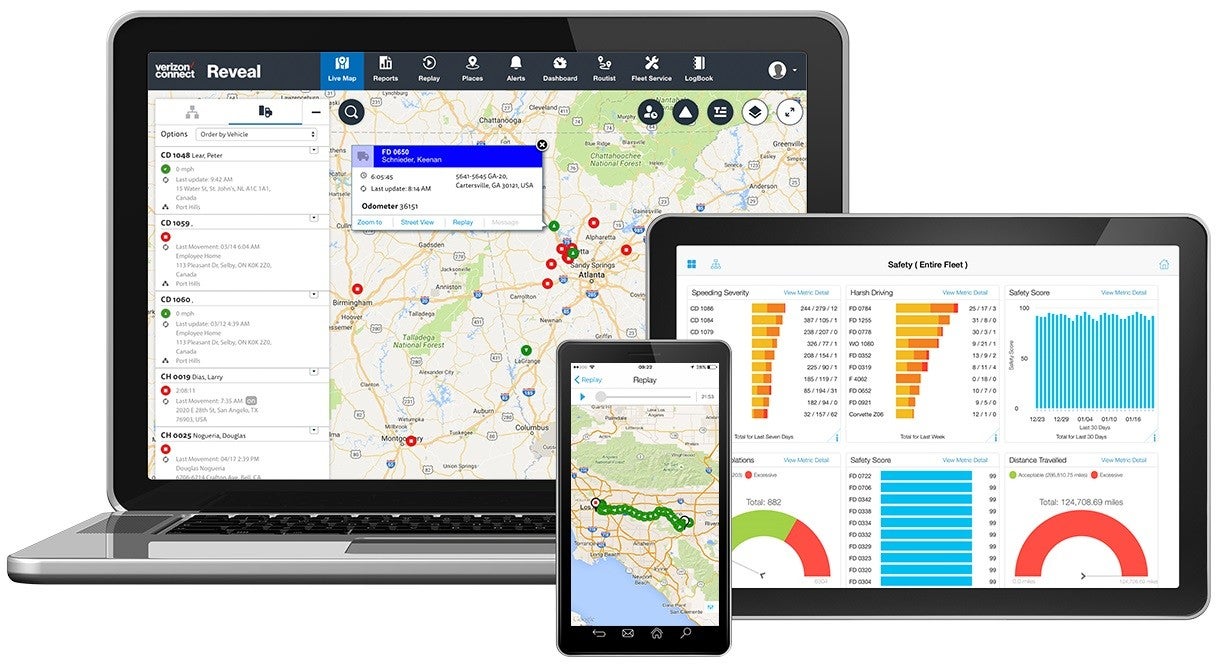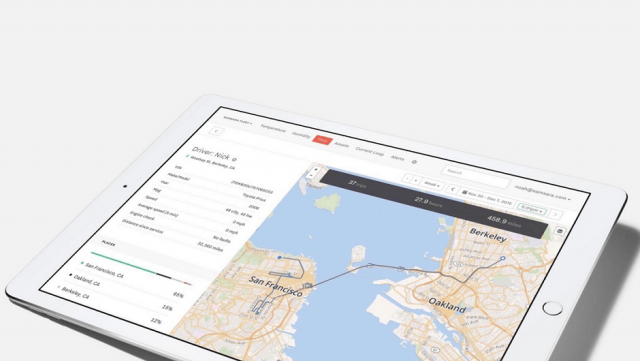Our content is funded in part by commercial partnerships, at no extra cost to you and without impact to our editorial impartiality. Click to Learn More
Fleet management is the process of organizing, tracking and maintaining a vehicle fleet, using a fleet management system (FMS). Typically, these commercial fleets will consist of cars, trucks and vans. Fleet management can also help businesses care for drivers’ health and safety, save money on fuel, and make sure that they’re obeying the law.
Typically, one of the best fleet management software solutions will cost about $20-35 a month, on average, per vehicle, or around $2000-$4500 per year for a fleet of 10 vehicles. This cost can vary significantly, dependent on your specific business needs, but the efficiencies and cost savings will bring a return on your investment that justifies the price tag.
In this guide, we’ll talk you through what fleet management costs actually are; the typical price range for GPS tracking with basic or advanced fleet management; the value differentiation factors to consider when picking one for your operation; and how these tools can, in the long run, save you more than you’ll spend.
Thanks to 24/7 real-time data monitoring and analytics, Fleet Management Software can boost a fleet’s efficiency, service and security. Plus, the top providers will have built-in ELD Mandate compliance, IFTA tools, and more.
What to Look for in a Fleet Management System
A fleet management system will normally have a hardware element — such as GPS trackers fitted to the vehicles — and a software element. The software element allows drivers to keep their records up to date, and gives bosses an easy way to see, at a glance, where their fleet is and how well they’re performing.
Fleet management systems can be used to dispatch drivers, provide route planning and traffic information, monitor fuel, and much more. If your business uses a fleet of vehicles, it’s well worth investing in this kind of service — especially now the ELD Mandate has come into force.
A fleet management system is a bundled combination of hardware and software that includes three elements:
- The Fleet Management Software device. Hardware sensors and an interface are installed or plugged into every vehicle in the fleet
- The vehicle software. This collects data like engine status and vehicle location from each vehicle
- The management interface software. Software that the fleet manager uses to receive and interpret data from all the vehicles.
Different fleet management software record different data. Those with sensors installed into a vehicle’s engine will receive more comprehensive data about the engine status than plug-and-go dashboard devices.
Some operations do only or mostly “less than truckload” (LTL) shipping, meaning that a single truck is delivering goods to multiple clients. These fleets should look for LTL-friendly fleet management software, which includes a specialized load optimization service not offered by TL-oriented fleet management software.
The best fleet management software come with active data trackers rather than passive ones. This means the data sent by an fleet management system might refresh as often as every few seconds or as rarely as every ten minutes. A passive tracker collects data on the go but only transfers it to the software later. Near-real-time data updates are essential for a truly effective fleet management software, so fleet managers can react quickly to important updates, such as late deliveries, or vehicle faults. Some fleet management software may even be operated using smartphone apps, making it even easier for managers to respond to situations.
Advanced fleet management solutions may also offer accessories such as in-cab driver coaching devices.
What’s the difference between GPS tracking and Fleet Management?
GPS trackers aren’t technically FMSs, as they typically don’t record anything beyond a vehicle’s location. They’re useful for personal anti-theft measures and limited fleet management, but won’t provide most of the benefits explained below.
Basic FMSs focus on only a few features. Logging driving hours and work breaks along with fuel management are features that tend to be covered. Fleet managers opting for a basic FMS should make sure it covers routing and dispatch at the very least, to be worth the investment.
Advanced FMSs include add-ons beyond just the necessities to maximize fleet efficiency and ROI. Parts, tire, and tool management might fall into this group of features, as well as accident and maintenance tracking. These systems usually offer ELD compliance, with the main goal of giving a fleet manager as much knowledge and power to run their business as possible.
In other words, GPS tracking is a subset of fleet management. Any FMS should be able to track vehicle location, with added features too.
FMS and ELD Compliance
An ELD, or electronic logging device, is a device with which all U.S. commercial motor vehicle drivers must record their hours of service, as required by the Federal Motor Carrier Safety Administration. You can read more about the guidelines and consequences for noncompliance in our full ELD mandate guide.
Not all FMSs are ELD compliant, but following the recent requirement that all HOS must be recorded through ELDs, most fleet management software vendors have made sure their service offers the option. Still, you should make sure your FMS has ELD compliance covered before you commit to it. We cover the best ELD devices on the market, just to give you an idea.
How many vehicles can I track?
Fleets of five vehicles can benefit from an FMS as much as those with thousands of vehicles. Some fleet management software vendors can serve larger fleets than others though. If an FMS provider is equipped with a large enough team of developers and customer service specialists, it can serve fleets of thousands of vehicles. Our fleet management software reviews outline the fleet size that provider can cover.
Fleet Management Video Guide
For a better understanding of how a fleet management system can transform a business, it’s helpful to look towards a case study.
Verizon Connect Reveal is one of the top fleet management providers around – click the video for a closer look at how this system can work.
Fleet Management Costs
Fleet management software pricing typically ranges from $15 to $50 per vehicle per month, depending on the features and size of your fleet.
For a small fleet of 10 vehicles with basic features, you can expect to pay around $15 per vehicle per month, or $180 per year. A larger fleet of 50 vehicles with more advanced features, such as real-time tracking and reporting, could cost upwards of $50 per vehicle per month, or $2,500 per year.
This table shows typical cost ranges per each vehicle in a fleet of trucks:
| GPS Tracker | Basic | Advanced | |
|---|---|---|---|
| Billed Monthly | Billed Annually | Installation Cost | |
| $10 – $15 | $100 – $150 | Free | |
| $3 – $25 | $35 – $250 | Free or $50 – $100 | |
| $30 – $55 | N/A | Free or $100 – $150 |
It’s worth understanding how much costs can vary depending on the scale and requirements of a business. The top fleet management providers will always tailor their costs around your needs. This can make it seem trickier to compare pricing – to help, we’d recommend using our simple fleet management pricing quotes tool. It takes just a minute to fill out, and can help you compare tailored quotes with ease.
What Influences Fleet Management Costs?
The total price given for an FMS potentially covers four different costs, though this can vary depending how each company structures its quotes:
- Devices — each vehicle must have a hardware device, which can be bought or leased
- Software licenses — a monthly or annual subscription fee covers the licensing of the software used, and varies depending on the services offered by the software
- Installation services — a wired device must be installed, while a plug-and-play device is not. Some FMS companies offer free installation, while others install devices for free only if the fleet signs a two or three-year contract, and some charge regardless.
- Training — some companies might offer training in the form of manuals, webinars, live online support, in-person sessions, or a combination of these
The price will also be affected by:
- Size of your fleet — almost all FMS companies charge per vehicle (or user) per month, so a larger fleet will pay more than a smaller fleet
- Features required — different FMSs track different types of data, from ELD compliance to fuel tracking to alerts on when best to rotate your tires, and on average, more extensive features will cost more
- Vendor — no FMS company is the same, and vendors’ prices can fluctuate
- Type of shipping service — Less-than-truckload (LTL) shipping operations should check to ensure an FMS tracks multiple destinations along a single route
- Additional hardware needed — Some further costs may be necessary, yet not included in FMS pricing. For example drivers might need company tablets or smartphones to access their data on the move, and use the FMS to pass roadside inspections. This would not be included in the FMS package.
Licensed or Owned?
FMS companies might sell the hardware device used to record data from within each vehicle. Alternatively, they might simply license these devices out to a fleet operation, taking the devices back should the operation choose to end its contract in the future. Regardless of which option you pick, the software may also be bought or licensed separately.
Licensing devices is a less expensive option, particularly if you’re licensing the software as well: If you switch to a different FMS, you likely won’t need the incompatible devices. You may choose to buy the devices if you want to avoid a lengthy two or three-year contract and plan to recoup the initial cost by using them for years into the future.
Wired or Plug-and-Play?
Wired FMS devices must be individually installed in each vehicle, connecting directly to the engine to monitor data that might otherwise go unrecorded, particularly on an older model (wired is best for models older than 1996, according to one manufacturer). Plug-and-play devices, however, simply plug into the dashboard.
If you have a light- or medium-duty vehicle, plug-and-play is likely a good option. If you have a heavy-duty vehicle or are opting for a discretely installed tracker for anti-theft protection, you should pick a wired device.
Fixed vs Operating Costs
When it comes to the cost of a particular asset, fleet expenses come in two forms: fixed and operating. Fixed costs describe charges that are consistent regardless of how the asset operates, which includes everything from taxes and insurance to licenses and lease payments.
On the other hand, operating costs are more variable and can change depending on the usage of the asset. These kind of costs include tolls, detailing, repairs, and even parking.
What Is TCO?
TCO is short for “total cost of ownership,” a term that refers to the actual cost of an asset, and includes all associated costs like maintenance and depreciation, as well as the initial acquisition cost. TCO can be calculated for a fleet vehicle by considering five core factors:
- Lifetime maintenance cost – How much it costs to repair a vehicle, including the rate of depreciation.
- Lifetime fuel usage – How much gas costs over the life of the vehicle.
- Licensing costs – How much it costs to get a vehicle properly licensed for your business.
TCO can be extremely valuable to understand, as it varies dramatically from business to business and even vehicle to vehicle. If you can find ways to better optimize the cost of your fleet, you can substantially impact your bottom line.
Fleet Management Savings
Initial costs for an FMS may seem high but one of the main reasons fleet managers love these tools is for the cost savings they get in return. How?
Fuel Savings
The data from fleet management software includes how long certain drivers allow their vehicles to idle, and how fast those idling vehicles burn through fuel. Paired with the improvements it offers in routing, a fleet tracking system can save the average operation 13.2% on fuel — which can account for as much as a third of an operation’s budget. And considering the cost of fueling vehicles is the number one operational risk for fleet management organizations, these kinds of features can make a big difference.

The cost of fueling vehicles is the number one operational risk to fleet management organizations.
Source: Tech.co
Less Harsh Braking
Sudden stops are also tracked by many FMSs, allowing fleet managers to note which drivers are braking harshly the most often. Cutting down on these incidents keeps a fleet’s brake pads in good condition longer, saving on repair costs.
Less Engine Idling Time
If the engine status is active but the vehicle is at rest, the fleet management software will know the engine is idling. The fleet manager can discuss excessive and frequent idling with their drivers to reduce future wasted time.
Less Overtime
Since FMSs track each driver’s overtime hours, fleet managers will be able to help drivers avoid overtime when it happens — and not learn about it when balancing the checkbook weeks later.
Faster Service
GPS-powered fleet management systems save transportation operations approximately 54 minutes per day, according to one Motorola study. Those numbers translated to $5,484 per employee.
Centralized Data
According to research from Aberdeen Group, fleet operations with an FMS are more than twice as likely to have a centralized repository for data collected on the road, to integrate that data into their back office, and to have data scientists dedicated to analyzing it. Granted, that correlation doesn’t necessarily mean the FMS causes this data-driven approach, but the FMS certainly provides the digital field data that allows it to happen.
With data on everything from vehicles’ downtime to the speed certain routes can be completed in, a fleet operation can optimize its dispatches: FMS information can go straight into a company’s bottom line.
Comply with regulations
It’s also the law. The ELD Mandate made it essential for businesses to track their drivers’ working hours using some sort of electronic logging device — a fleet management system will help you do this.
Better safety
Fast response times can make a difference, and any GPS fleet tracking system can alert a fleet manager within minutes from anywhere on the globe. Pen and paper systems can’t do that.
Plus, since most FMSs collect data on driver’s unsafe habits, from harsh breaking to tight turns to speeding, a manager can address concerns before they turn into traffic collisions. How large an impact does an FMS have on fleet safety? According to the Federal Motor Carrier Safety Administration itself, ELDs are estimated to save 26 lives per year.
Fewer emissions
Since an FMS can track and ultimately cut down on fuel costs, your operation will burn less CO2 to get where it’s going. By one operation’s estimate, saving $250 in annual fuel costs per vehicle will cut carbon emissions by 2,500 pounds per vehicle each year.
Less travel time
Fleet management systems are designed to find the shortest and most fuel-effective route, and to avoid empty runs when possible. One side-effect: Drivers will have the downtime they need between routes. One Nustats study found that drivers with traffic-sensitive navigation systems can cut 18% on the road on any given trip. For the average driver, that’s a full four days out of the year.
Save money
In our research, we found that saving money is a supreme priority across the fleet management industry. In fact, reducing operating costs was the number one priority for fleet management organizations, with increasing efficiency and improving drive productivity rounding out the top three.

Reducing operating costs is the number one priority for fleet management organizations.
Source: Tech.co
On top of that, the cost of fleet management is stifling innovation at some companies as well. In fact, our research found that it’s the number one barrier to organizations that are interested in using new technology in fleet management. Suffice to say, cost is clearly on the mind.
Luckily, because of all the reasons listed above, fleet management can streamline your business in a way that makes you more money while saving you costs in the meantime. Not complying with regulations leads to fines, poor safety leads to lawsuits, and longer travel times leads to higher fuel costs. Subsequently, the investment is more than worth it in the long run.

Budget constraints are the number one barrier to the use of new technology in fleet management.
Source: Tech.co
Other benefits of fleet management
That’s not all, though. There are a vast array of other benefits that can help your fleet management business. A good fleet management system will also help you with:
- Dispatch management — route planning and communication with drivers
- Tracking and diagnostics — live data on vehicle location and status
- Fuel management — data on how quickly fuel is used
- Vehicle maintenance — customizable maintenance alerts can be set
- Financing — data on the wear and tear vehicles undergo
- Health management — data on the duration of drivers’ work hours and breaks
- Safety management — data on vehicles’ driving and cornering speed can identify high-risk drivers
A typical fleet management system collects this data while plugged into or installed in a vehicle’s dashboard. It then sends the data via a GPS to a fleet manager’s central hub.
A fleet management software also benefits a fleet operation through a few measures that may not result in immediate savings but can prevent potential catastrophes down the (metaphorical) road.
- Anti-theft — Sure, managers can purchase separate anti-theft trackers, but if a fleet management software is on board, it will track a vehicle’s location at no extra charge.
- Vehicular control — Some fleet management systems don’t merely track data but are given a measure of control over the engine, allowing managers to remotely limit speeds or slow and stop vehicles when necessary, preventing mistakes or collisions.
Fleet Management Best Practice
As with any management software, fleet management software opens fleet managers up to a few vulnerabilities if not used responsibly. Here are the downsides to fleet management systems that you should be aware of.
Don’t Intrude on Privacy
A fleet management software isn’t exactly designed to respect a vehicle drivers’ privacy. It records their speeding habits, their location, and how quickly they take a 90-degree turn, after all. This is perfectly legal during working hours, though employees should be made aware of what’s being tracked and why. However, if a fleet operator’s vehicles are ever used privately by employees, the operator should take care to disable the fleet management software for these trips.
Manage Drivers’ Expectations
Speaking of privacy, drivers in a fleet may be upset at switching to a fleet management software and away from a passive GPS tracker or a paper logging system. Having their driving habits and overtime tracked may make them uncomfortable. The best approach to introducing a fleet management system is transparency and open communication. Depending on the fleet management software provider, driver training courses may be provided to ease them into the new process.
Some businesses also choose to alleviate any negative feelings employees might have around tracking by providing rewards based on the new data. For example by offering bonuses to the most fuel-efficient drivers or those with the lowest records of harsh braking. These awards can be allocated easily using the driver scorecard reports offered by many fleet management systems.
| Price From The typical lowest starting price. The lowest price available for your business will depend on your needs. | Free Trial or Demo | |||||||||
|---|---|---|---|---|---|---|---|---|---|---|
| SPONSORED | BEST OVERALL | BEST FEATURES |  | |||||||
| GPS Insight | Intellishift | |||||||||
| $13.95 | $19.99/vehicle/month | |||||||||
| Free trial upon request; software and hardware | 30-day free trial; hardware and software | Free online demo | Free live demo | 14-day free trial | Free demo | Demo | Free online demo | 4-week trial | Free demo |
You’ll notice immediately from the table above that there are some big differences, from $5 per vehicle, per month to over $40. Scaled up across a year for a small to medium fleet, and this difference can quickly become thousands of dollars.
We take our impartial research and analysis seriously, so you can have complete confidence that we're giving you the clearest, most useful recommendations.
After conducting an initial exploration to identify the most relevant, popular, and established tools in the market, we put them through their paces with several rounds of testing to see their real strengths and weaknesses. In this case, we put 29 fleet management products to the test across 51 areas of investigation.
Based on years of market and user needs research, we've established a fleet management testing methodology that scores each product in six main categories of investigation and six additional subcategories; this covers everything from the driver management features to value for money and customer support, as well as much more.
Our main testing categories for fleet management systems are:
Price: the cost associated with using the fleet management software, including upfront costs, subscription fees, hardware costs (if applicable), and any additional charges for advanced features or add-ons.
Tracking: the core functionality of the fleet management software, which involves monitoring and tracking the location and movements of vehicles in real-time, such as GPS tracking, route optimization, and geofencing.
Driver Management: the features and tools provided by the fleet management software to manage and monitor driver activities. This can include driver behavior monitoring, driver performance reports, driver identification.
Vehicle Management: the functionalities that allow for the efficient management and maintenance of vehicles, such as vehicle health monitoring and maintenance scheduling.
Product Features: the additional functionalities and capabilities offered by the fleet management software beyond basic tracking and management, such as real-time alerts and notifications or driver routing and dispatching.
Support: the resources, assistance, and guidance provided by the fleet management software company to users, including phone support, email or chat support, and online forums.
When it comes to calculating a product's final score, not all testing areas are weighted evenly, as we know some aspects matter more to our readers than others, which are merely "nice to have." After hundreds of hours, our process is complete, and the results should ensure you can find the best solution for your needs.
At Tech.co, we have a number of full time in-house researchers, who re-run this testing process regularly, to ensure our results remain reflective of the present day.
Get Started with Fleet Management Today
If you want to improve the management of your commercial fleet, a fleet management system is a great place to start — whether you’re running a business with five pizza delivery vehicles, or thousands of semis. You’ll be more efficient with planning driver routes, managing the upkeep of your vehicles, and monitoring driver workloads. What’s more, your business will be fully compliant with the ELD mandate.
So if you’re looking to get started with a fleet management system, you can get quotes from the leading providers quickly and easily by filling out our free online form.
If you click on, sign up to a service through, or make a purchase through the links on our site, or use our quotes tool to receive custom pricing for your business needs, we may earn a referral fee from the supplier(s) of the technology you’re interested in. This helps Tech.co to provide free information and reviews, and carries no additional cost to you. Most importantly, it doesn’t affect our editorial impartiality. Ratings and rankings on Tech.co cannot be bought. Our reviews are based on objective research analysis. Rare exceptions to this will be marked clearly as a ‘sponsored’ table column, or explained by a full advertising disclosure on the page, in place of this one. Click to return to top of page









